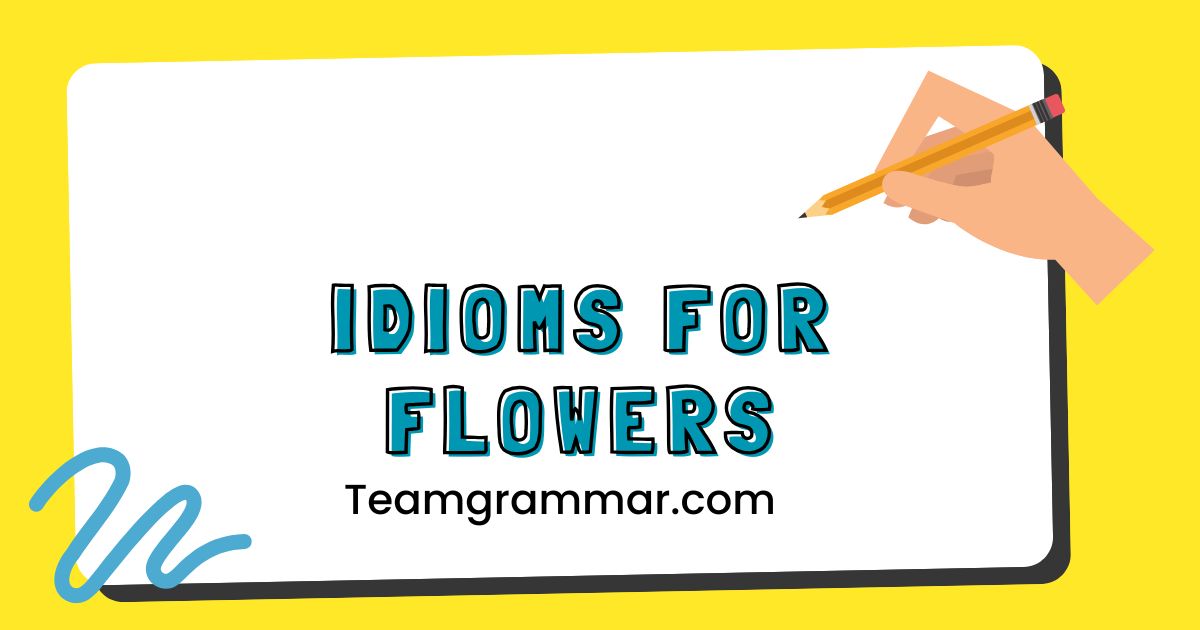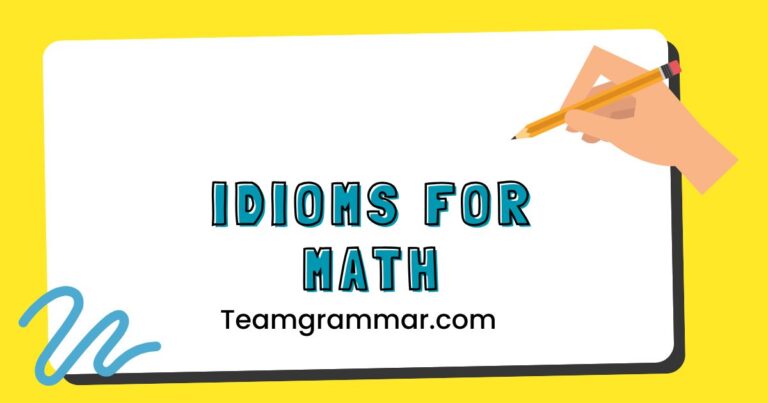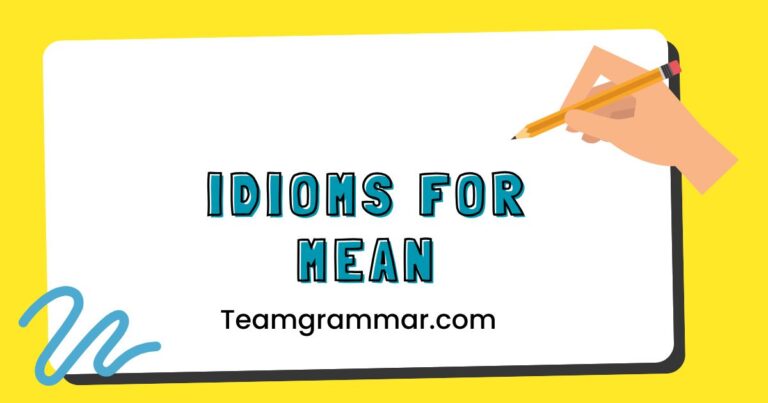41 Idioms for Flowers: Blooming Your English Vocabulary
Idioms add color and depth to the English language, allowing speakers to express complex ideas in concise and vivid ways. Understanding flower-related idioms is particularly useful for both native speakers and English language learners.
These idioms often carry cultural significance and can enhance your understanding of nuanced communication. This article explores a wide range of flower idioms, their meanings, origins, and usage, helping you to incorporate them effectively into your everyday conversations and writing.
Mastering these idioms will not only enrich your vocabulary but also improve your overall comprehension and fluency in English.
Table of Contents
- Introduction
- Definition of Idioms
- Structural Breakdown of Flower Idioms
- Types and Categories of Flower Idioms
- Examples of Flower Idioms
- Usage Rules for Flower Idioms
- Common Mistakes with Flower Idioms
- Practice Exercises
- Advanced Topics in Flower Idioms
- Frequently Asked Questions
- Conclusion
Introduction
Idioms are an integral part of the English language, offering a unique way to express thoughts and ideas beyond their literal meanings. Flower idioms, in particular, often draw upon the symbolism and beauty associated with flowers to convey a range of emotions, situations, and characteristics.
These idioms are not only colorful and descriptive but also deeply rooted in cultural contexts, making them essential for effective communication. By understanding and using flower idioms correctly, you can enhance your fluency and comprehension, making your English more expressive and engaging.
This comprehensive guide will explore various flower idioms, their meanings, origins, and how to use them appropriately in different contexts.
Definition of Idioms
Anidiomis a phrase or expression whose meaning cannot be understood from the literal meanings of the individual words within it. Instead, an idiom has a figurative meaning that is known through common usage and cultural context.
Idioms are often specific to a particular language or region, which makes them challenging for language learners to grasp. They add richness and nuance to communication, allowing speakers to convey complex ideas more succinctly and creatively than literal language would permit.
Understanding idioms is crucial for achieving fluency and comprehending the subtle cultural aspects of a language.
In the context of English grammar, idioms are considered fixed expressions. This means that the words within the idiom cannot be changed or rearranged without altering or losing the intended meaning.
Idioms often function as single units of meaning and can act as nouns, verbs, adjectives, or adverbs within a sentence. Their function depends on the specific idiom and the context in which it is used.
Mastering idioms requires not only memorization but also an understanding of the cultural and historical background that contributes to their meaning.
Structural Breakdown of Flower Idioms
Flower idioms, like all idioms, are fixed phrases with non-literal meanings. Their structure typically involves a combination of nouns (referring to flowers), verbs, and adjectives that create a metaphorical image.
The structural elements of these idioms often play a crucial role in conveying the intended meaning. Understanding the structural breakdown can help learners recognize and interpret flower idioms more effectively.
Common structural patterns include:
- Noun + Verb: The flower (noun) is associated with an action (verb) that conveys a particular meaning. Example: “nip something in the bud.”
- Adjective + Noun: An adjective modifies the flower (noun) to create a specific image and meaning. Example: “shrinking violet.”
- Prepositional Phrases: These phrases add context and depth to the idiom’s meaning. Example: “under the rose.”
The effectiveness of flower idioms lies in their ability to evoke vivid imagery and emotional associations. By combining familiar floral imagery with unexpected actions or descriptions, these idioms create memorable and meaningful expressions.
The structure of each idiom is carefully crafted to ensure that the figurative meaning is clear and impactful. Analyzing the structural components of flower idioms can enhance comprehension and facilitate their proper use.
Types and Categories of Flower Idioms
Flower idioms can be categorized based on the specific flower they reference and the type of meaning they convey. Understanding these categories can help learners organize and remember the idioms more effectively.
Here are some common categories:
General Flower Idioms
These idioms use the general concept of flowers to convey a broader range of meanings, often related to growth, beauty, or fragility. They do not refer to a specific type of flower but rather use the general symbolism associated with flowers.
Rose Idioms
Rose idioms often symbolize love, beauty, and perfection. The rose is a popular flower in literature and culture, and many idioms draw upon its rich symbolism to convey emotions and ideas related to romance, beauty, and sometimes hidden dangers.
Lily Idioms
Lily idioms are less common but often associated with purity, innocence, and mourning. Lilies are often used in religious ceremonies and funerals, which contributes to their symbolic meaning in idioms.
Daisy Idioms
Daisy idioms are relatively rare, but daisies are often associated with innocence and simplicity. They might appear in idioms related to naivety or carefree attitudes.
Other Flower-Related Idioms
This category includes idioms that reference other specific flowers such as tulips, sunflowers, or orchids. Each flower carries its own unique symbolism, which is reflected in the idioms that use it.
Examples of Flower Idioms
This section provides extensive examples of flower idioms, organized by category. Each example includes the idiom, its meaning, and several example sentences to illustrate its usage.
These examples will help you understand the context in which each idiom is typically used and how to incorporate them into your own speech and writing.
General Flower Idioms
General flower idioms use the concept of flowers to convey broader meanings related to growth, beauty, or fragility. These idioms are versatile and can be used in various contexts to add color and depth to your language.
The following table provides a detailed list of general flower idioms with their meanings and examples.
| Idiom | Meaning | Example Sentences |
|---|---|---|
| Nip something in the bud | To stop something at an early stage before it develops further. | The teacher nipped the bullying in the bud by addressing it immediately. |
| Shrinking violet | A shy or timid person. | She’s no shrinking violet; she’s always the first to speak up in meetings. |
| A late bloomer | Someone who develops their talents or abilities later in life than others. | He was a late bloomer in sports, but he eventually became a star athlete. |
| Pushing up daisies | To be dead and buried. | If I don’t finish this project on time, I’ll be pushing up daisies. |
| Everything’s coming up roses | Everything is going well; things are looking positive. | Since she got the promotion, everything’s coming up roses for her. |
| No bed of roses | A situation that is not easy or pleasant. | Being a doctor is no bed of roses; it requires long hours and dedication. |
| Fresh as a daisy | Energetic and full of life; refreshed. | After a good night’s sleep, she woke up feeling as fresh as a daisy. |
| Scatter like seeds | To disperse quickly and widely. | When the alarm sounded, the students scattered like seeds across the campus. |
| Flower child | A person, typically a young one, associated with the hippie subculture of the 1960s and 1970s, characterized by a rejection of conventional values and the advocacy of peace and love. | During the reunion, she reminisced about her days as a flower child, advocating for peace and love. |
| Flower power | The ideology of passive resistance. | The protesters used flower power to advocate for peace and change during the demonstration. |
| A budding artist | A young artist who is showing promise and potential. | The art gallery showcased the works of several budding artists from the local community. |
| Bloom where you are planted | To make the most of your current situation and find happiness and fulfillment wherever you are. | She decided to bloom where she was planted, volunteering and making new friends in her new town. |
| Winter flower | A plant that blossoms in cold weather. | The winter flower added a touch of color to the otherwise bleak landscape. |
| Flower language | The Victorian practice of conveying messages through the symbolism of different flowers. | They exchanged flowers, using flower language to express their unspoken feelings. |
| Flower arrangement | The art of organizing and displaying flowers in a decorative way. | She took a class in flower arrangement to learn how to create beautiful displays for her home. |
| Flower garden | A garden specifically designed for growing flowers. | They spent their weekends tending to their flower garden, filled with colorful blooms. |
| Flower crown | A decorative wreath of flowers worn on the head. | She wore a flower crown to the music festival, embracing the bohemian vibe. |
| Flower delivery | The service of sending flowers to someone’s home or workplace. | He arranged for a flower delivery to surprise his wife on their anniversary. |
| Flower girl | A young girl who scatters flower petals down the aisle at a wedding. | The flower girl looked adorable as she walked down the aisle, scattering petals. |
| Flower bed | A section of a garden used for growing flowers. | She planted tulips and daffodils in the flower bed, creating a vibrant display. |
| Flower box | A container placed on a windowsill or balcony for growing flowers. | The flower box added a splash of color to the apartment’s balcony. |
| Flower power | The belief in the power of love and peace to overcome violence and war, often associated with the hippie movement. | The protesters advocated for peace using flower power as a symbol of non-violence. |
| Flower show | An exhibition of flowers and plants, often with competitions and displays. | They attended the annual flower show to admire the beautiful displays and floral arrangements. |
| Flower market | A market where flowers are sold, often with a wide variety of blooms and arrangements. | She visited the flower market to buy fresh flowers for her wedding bouquet. |
Rose Idioms
Rose idioms often symbolize love, beauty, and perfection. The rose is a popular flower in literature and culture, and many idioms draw upon its rich symbolism to convey emotions and ideas related to romance, beauty, and sometimes hidden dangers.
The following table provides rose idioms with their meanings and examples.
| Idiom | Meaning | Example Sentences |
|---|---|---|
| Come up roses | To turn out well in the end, despite initial difficulties. | Despite the initial setbacks, the project came up roses in the end. |
| Stop and smell the roses | To take time to appreciate the good things in life. | We need to stop and smell the roses and enjoy the present moment. |
| Under the rose | Secretly or confidentially. | The deal was negotiated under the rose to avoid public scrutiny. |
| A bed of roses | An easy and pleasant situation. | Life as a celebrity may seem like a bed of roses, but it has its challenges. |
| Rose-colored glasses | A positive or optimistic view of things, often unrealistic. | She always looks at the world through rose-colored glasses, ignoring the problems. |
| Prickly as a rose | Having a difficult or defensive personality. | Despite her talent, her prickly as a rose attitude made it difficult to work with her. |
| Smelling like roses | To appear innocent or blameless, even if one is not. | He tried to make the situation smelling like roses, but everyone knew he was responsible. |
| Rose to the occasion | To perform well in a difficult situation. | Despite the pressure, she rose to the occasion and delivered an outstanding performance. |
| Rose above | To overcome a difficult situation or negative influence. | He rose above his humble beginnings to achieve great success in his career. |
| Rose water | A fragrant liquid made from rose petals, often used in cosmetics and cooking. | She added rose water to her skincare routine for its soothing and hydrating properties. |
| Rose garden | A garden specifically designed for growing roses. | They strolled through the rose garden, admiring the variety of colors and fragrances. |
| Rose hips | The fruit of the rose plant, often used in teas and jams. | She made rose hips tea to boost her immune system during the winter months. |
| Rose quartz | A pink-colored crystal associated with love and compassion. | She wore a rose quartz necklace to promote feelings of self-love and acceptance. |
| Rose window | A circular stained glass window often found in churches and cathedrals. | The rose window in the cathedral cast a beautiful array of colors onto the floor. |
| Rose Festival | An annual festival celebrating roses, typically held in cities known for rose cultivation. | They attended the annual Rose Festival to admire the floral displays and parades. |
| Rose Bowl | A prestigious college football game held annually in Pasadena, California. | Their favorite team won the Rose Bowl, bringing pride to their university. |
| Roseate spoonbill | A bird with pink plumage and a spoon-shaped bill. | They spotted a roseate spoonbill while birdwatching in the Florida Everglades. |
| Rose fever | Enthusiasm or excitement about roses, often leading to collecting or growing them. | He caught rose fever after visiting the rose garden and started collecting rare varieties. |
| Rose oil | An essential oil extracted from rose petals, used in aromatherapy and skincare. | She used rose oil in her aromatherapy diffuser to create a calming and romantic atmosphere. |
| Rose-tinted | Idealized or unrealistic. | Her memories of childhood were rose-tinted, ignoring the hardships she had faced. |
| Rose blush | A cosmetic product used to add a rosy color to the cheeks. | She applied rose blush to enhance her complexion and add a healthy glow. |
| Rose pattern | A design featuring roses, often used in fabrics, wallpapers, and ceramics. | The wallpaper in her bedroom featured a delicate rose pattern, creating a romantic ambiance. |
| Rose scent | The fragrance of roses, often used in perfumes and lotions. | She loved the rose scent of her favorite perfume, which reminded her of her grandmother’s garden. |
Lily Idioms
Lily idioms are less common but often associated with purity, innocence, and mourning. Lilies are often used in religious ceremonies and funerals, which contributes to their symbolic meaning in idioms.
The following table contains lily idioms and their meanings.
| Idiom | Meaning | Example Sentences |
|---|---|---|
| Gilding the lily | To spoil something that is already beautiful by adding unnecessary ornamentation. | The performance was already excellent; adding more special effects would be gilding the lily. |
| White as a lily | Pure, innocent, or virtuous. | She looked as white as a lily in her wedding dress, radiating purity and grace. |
| Lily-livered | Cowardly or lacking courage. | He was too lily-livered to stand up to the bully. |
| Lily of the valley | A fragrant woodland plant with bell-shaped white flowers, often associated with sweetness and humility. | She carried a bouquet of lily of the valley at her wedding, symbolizing purity and happiness. |
| Water lily | An aquatic plant with floating leaves and showy flowers. | The pond was covered with water lilies, creating a serene and picturesque scene. |
| Calla lily | A plant with elegant, trumpet-shaped flowers, often used in weddings and funerals. | The calla lily arrangement added a touch of sophistication to the event. |
| Daylily | A plant with large, showy flowers that bloom for only one day. | The daylilies in the garden provided a burst of color during the summer months. |
Daisy Idioms
Daisy idioms are relatively rare, but daisies are often associated with innocence and simplicity. They might appear in idioms related to naivety or carefree attitudes.
Here are some daisy-related idioms.
| Idiom | Meaning | Example Sentences |
|---|---|---|
| Fresh as a daisy | Energetic and full of life; refreshed. | After a good night’s sleep, she woke up feeling as fresh as a daisy and ready to start the day. |
| Daisy chain | A chain of daisies made by threading the stem of one daisy through a slit in another. | The children spent the afternoon making daisy chains in the meadow. |
| Pushing up daisies | To be dead and buried. (Often used humorously). | If I don’t get this project done, I’ll be pushing up daisies. |
Other Flower-Related Idioms
This category includes idioms that reference other specific flowers such as tulips, sunflowers, or orchids. Each flower carries its own unique symbolism, which is reflected in the idioms that use it.
The following table contains flower idioms related to other specific flowers and their meanings.
| Idiom | Meaning | Example Sentences |
|---|---|---|
| Two lips (Tulips) | A humorous or playful way to refer to kissing someone. | He gave her two lips before leaving for work. |
| Follow the sunflowers | To seek out positivity and happiness. | Whenever she feels down, she tries to follow the sunflowers and find joy in the small things. |
| Orchidaceous | Resembling an orchid; elegant and refined. | The orchidaceous design of the building impressed everyone who visited. |
| As delicate as a petal | Extremely fragile or sensitive. | Her skin was as delicate as a petal, requiring gentle care. |
| Thistle do nicely | A pun on “this’ll do nicely,” using “thistle” as a play on words. | “Will this pen work for signing the document?” “Yes, thistle do nicely!” |
| Buttercup | A term of endearment, often used for a child or loved one. | “Come here, buttercup,” she said to her granddaughter, hugging her tightly. |
Usage Rules for Flower Idioms
Using flower idioms correctly requires understanding their specific meanings and the contexts in which they are appropriate. Here are some guidelines to follow:
- Context Matters: Always consider the context of your conversation or writing before using an idiom. Ensure that the idiom fits the tone and style of your communication.
- Know the Meaning: Be certain of the idiom’s meaning before using it. Misusing an idiom can lead to confusion or miscommunication.
- Audience Awareness: Consider your audience. Some idioms may not be familiar to non-native speakers or people from different cultural backgrounds.
- Avoid Overuse: While idioms can add color to your language, overuse can make your communication sound forced or unnatural.
- Maintain Grammatical Consistency: Ensure that the idiom fits grammatically within your sentence. Do not alter the structure of the idiom, as this can change its meaning.
Flower idioms often carry cultural and historical connotations. Being aware of these associations can help you use the idioms more effectively and avoid potential misunderstandings.
For example, the idiom “under the rose” originates from the ancient Roman practice of hanging a rose above meeting places to indicate that discussions were confidential. Understanding this origin can add depth to your appreciation of the idiom.
Common Mistakes with Flower Idioms
One of the most common mistakes is using an idiom in the wrong context. For example, saying “He’s pushing up daisies at work” is incorrect because the idiom means someone is dead, which doesn’t fit the context of being at work.
Another common mistake is altering the words of an idiom. For instance, saying “Nip it in the leaf” instead of “Nip it in the bud” changes the meaning and sounds incorrect.
It’s also important to be aware of the audience. Using idioms that are too obscure or culturally specific can confuse listeners or readers.
Here are some examples of common mistakes and their corrections:
| Incorrect | Correct | Explanation |
|---|---|---|
| “He’s always smelling the roses at work.” | “He needs to stop and smell the roses.” | The idiom is “stop and smell the roses,” not “smelling the roses.” |
| “Everything is coming up sunflowers.” | “Everything is coming up roses.” | The idiom is “everything is coming up roses,” not “sunflowers.” |
| “She’s a growing violet.” | “She’s a shrinking violet.” | The idiom is “shrinking violet,” referring to a shy person. |
| “Nip it in the leaf.” | “Nip it in the bud.” | The idiom is “nip it in the bud,” meaning to stop something early. |
| “Life is a bed of thorns.” | “Life is no bed of roses.” | The idiom is “no bed of roses,” meaning life is not easy. |
Practice Exercises
Test your understanding of flower idioms with these practice exercises. Fill in the blanks with the appropriate idiom from the list provided.
Idiom List: Nip something in the bud, Shrinking violet, A late bloomer, Pushing up daisies, Everything’s coming up roses, No bed of roses, Fresh as a daisy, Under the rose, Stop and smell the roses, Gilding the lily
- She woke up feeling as ________ after her vacation.
- The teacher decided to ________ the problem ________ before it escalated.
- He’s always been a ________, achieving success later in life.
- The detective discovered that the deal was done ________.
- Being a single parent is ________.
- Since they won the lottery, ________ for them.
- We should ________ and enjoy the simple things in life.
- Adding more decorations to the cake would be ________.
- If I fail this exam, I’ll be ________.
- She’s such a ________, always hiding in the corner.
Answer Key:
- Fresh as a daisy
- Nip something in the bud
- A late bloomer
- Under the rose
- No bed of roses
- Everything’s coming up roses
- Stop and smell the roses
- Gilding the lily
- Pushing up daisies
- Shrinking violet
Exercise 2: Match the idiom with its correct meaning.
| Idiom | Meaning |
|---|---|
| 1. Come up roses | A. To spoil something already beautiful |
| 2. Gilding the lily | B. To be dead and buried |
| 3. Pushing up daisies | C. To turn out well in the end |
| 4. Rose-colored glasses | D. An easy and pleasant situation |
| 5. A bed of roses | E. A positive or optimistic view of things, often unrealistic |
Answer Key:
- 1-C
- 2-A
- 3-B
- 4-E
- 5-D
Exercise 3: Choose the correct idiom to complete each sentence.
- Despite the challenges, the project eventually ________.
- a) came up roses
- b) pushed up daisies
- c) nipped in the bud
- She tends to look at her past through ________, remembering only the good times.
- a) rose-colored glasses
- b) shrinking violet
- c) fresh as a daisy
- The manager decided to ________ the rumors ________ before they spread further.
- a) gilding the lily
- b) nip something in the bud
- c) stop and smell the roses
- After a relaxing spa day, she felt as ________.
- a) under the rose
- b) fresh as a daisy
- c) a late bloomer
- He confided in her ________, trusting her not to reveal his secret.
- a) under the rose
- b) no bed of roses
- c) pushing up daisies
Answer Key:
- a) came up roses
- a) rose-colored glasses
- b) nip something in the bud
- b) fresh as a daisy
- a) under the rose
Advanced Topics in Flower Idioms
For advanced learners, exploring the etymology and cultural context of flower idioms can provide a deeper understanding of their meaning and usage. Researching the historical origins of idioms like “under the rose” or “gilding the lily” can reveal fascinating insights into their evolution and significance.
Additionally, analyzing how flower idioms are used in literature and popular culture can enhance your appreciation of their expressive power. Consider the works of poets, novelists, and playwrights who have skillfully incorporated flower idioms into their writing to convey complex emotions and themes.
For example, Shakespeare’s use of floral imagery often adds layers of meaning to his characters and plots. Furthermore, exploring regional variations in flower idioms can broaden your understanding of the diverse ways in which English is used around the world.
Some idioms may be more common in certain countries or regions, reflecting local cultural traditions and linguistic preferences.
Another advanced topic is the creation and evolution of new idioms. Language is constantly evolving, and new idioms emerge over time to reflect changing cultural norms and experiences.
By paying attention to current trends in language use, you can identify potential new flower idioms that are gaining popularity. For example, with the increasing focus on environmentalism, new idioms related to sustainability and nature may emerge, incorporating floral imagery in innovative ways.
Analyzing these trends can help you stay current with the latest developments in the English language and enhance your ability to communicate effectively in a variety of contexts.
Frequently Asked Questions
- What is the difference between an idiom and a literal expression?
An idiom is a phrase whose meaning cannot be understood from the literal meanings of its individual words. A literal expression, on the other hand, means exactly what the words say.
- Why are idioms important in English?
Idioms add color, depth, and nuance to the English language. They allow speakers to express complex ideas in concise and vivid ways. Understanding idioms is essential for achieving fluency and comprehending the subtle cultural aspects of the language.
- How can I learn flower idioms effectively?
Start by studying lists of common flower idioms and their meanings. Pay attention to how they are used in context through reading and listening to native speakers. Practice using the idioms in your own speech and writing.
- Are flower idioms used in formal writing?
While flower idioms can be used in formal writing, it’s important to consider the tone and style of your communication. Some idioms may be more appropriate for informal contexts, while others can be used effectively in formal writing to add a touch of creativity and expressiveness.
- Can I translate flower idioms directly into another language?
No, idioms are often specific to a particular language and culture. Translating them directly into another language will likely result in a nonsensical or incorrect meaning. Instead, try to find an equivalent idiom in the target language that conveys a similar idea.
- What should I do if I don’t understand a flower idiom?
Look up the idiom in a dictionary or online resource that provides definitions and examples. If the context is unclear, ask a native speaker to explain the meaning and usage of the idiom.
- How can I avoid misusing flower idioms?
Be certain of the idiom’s meaning before using it. Consider the context of your communication and your audience. Avoid altering the structure of the idiom, as this can change its meaning.
- Are there any flower idioms that should be avoided?
Some flower idioms may be considered outdated or offensive depending on the context and audience. Be mindful of cultural sensitivities and avoid using idioms that may be perceived as insensitive or inappropriate.
- How do flower idioms reflect cultural values?
Flower idioms often reflect cultural values and beliefs associated with specific flowers. For example, rose idioms often symbolize love and beauty, reflecting the cultural significance of roses in romance and aesthetics. Lily idioms may reflect associations with purity and mourning, reflecting their use in religious ceremonies and funerals.
- Can flower idioms be used metaphorically?
Yes, flower idioms are inherently metaphorical, as they use floral imagery to convey non-literal meanings. This metaphorical usage allows for creative and expressive communication, adding depth and nuance to the English language.
Conclusion
Flower idioms offer a rich and colorful way to enhance your English vocabulary and improve your communication skills. By understanding the meanings, origins, and usage rules of these idioms, you can express complex ideas more creatively and effectively.
Remember to consider the context, know your audience, and avoid overuse to ensure that your use of flower idioms is appropriate and impactful. Continue to practice and explore new idioms to expand your linguistic repertoire and deepen your appreciation for the nuances of the English language.
Mastering flower idioms, like any aspect of language learning, requires consistent effort and attention. Don’t be afraid to make mistakes – they are a natural part of the learning process.
Embrace the challenge of learning new expressions and incorporate them into your daily conversations and writing. With dedication and practice, you will be able to use flower idioms confidently and fluently, adding a touch of beauty and expressiveness to
your communication.







